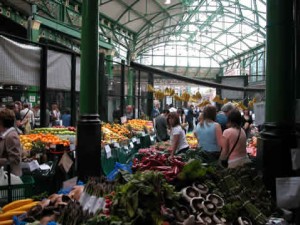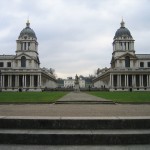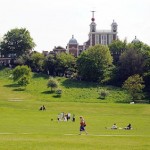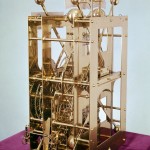I spent my last day in the U.K., after taking care of some business matters, wih my friends Skye and Natasha, Canadians living in London.
Skye took me to visit Burrough Market, near London Bridge. Housed in a confusingly laid out Victorian structure, and milling with people, the market is a delightful chaos. There has been a market on the site, or at least nearby, for two thousand years. Burrough Market combines retail and wholesale functions, and there’s a certain amount of grime. This and the constant shouting of hawkers contrasts with the antiseptic quiet that pervades St. Lawrence Market in Toronto. We had some fine Persian pastries.
But the main item on our agenda was Greenwich. Skye and I are both fond of a 2000 television mini-series called Longitude, starring Jeremy Irons and Michael Gambon. This tells two parallel stories, one in the 18th Century and the other in the mid-Twentieth. The first relates the struggle of inventor John Harrison to perfect a marine chronometer that would allow sailors to calculate longitude at sea. The second tells the the story of Rupert Gould, who rescued the surviving chronometers from storage and got them to work again. The four surviving chronometers are profoundly important in the history of technology, among the most significant objects in human history. They are preserved in the Royal Observatory, Greenwich, in the complex of museums associated with the Naval Hospital and the Observatory constructed by Christopher Wren. The Observatory preserves important treasures in astronomy, chronometry, and navigation, while the National Maritime Museum houses exhibits appropriate to an Empire built on sea power. Like all of Britain’s national museums, there is no admittance charge. I wish people in Canada, who are accustomed to pay admission to public museums, would take note of this. While we have some fine museums, I am grossly offended by the attitude that imagines it appropriate for us to be charged a fee to look at our own stuff. It is as ridiculous as setting up a pay toilet in your own home.
Natasha, Skye and I dined at a Panjabi restaurant on the Kilburn High Road. The curry was bland compared with what would be served in Toronto, which Skye said was typical of London taste.
The flight home was marked by an unusual clearing of the skies over Kalaallit Nunaat, so I got a magnificent view of the Greenland Ice Cap.
My trip had been hurried, and I seldom stayed long enough in one spot to really appreciate what I was seeing, but, as always, I was happy to be back home in Canada. My cat, Enkidu, had survived a week of being locked indoors without too much trauma. I was now condemned to return to inferior fish and chips, but I could again eat curry with the proper fire in it. I had picked up a bottle of Bell’s Scotch at Duty Free, prudently passing on the chance of purchasing a ₤6,000 Isle of Skye. I had the whiskey, some genuine Orcadian oatcakes and cheese, a bottle of Orkney’s Red MacGregor (“Five thousand years in the making!”), and a genuine Matchbox london bus, made in England in 1972, not a Taiwanese knock-off. These will console me as life returns to its tepid norm.




0 Comments.